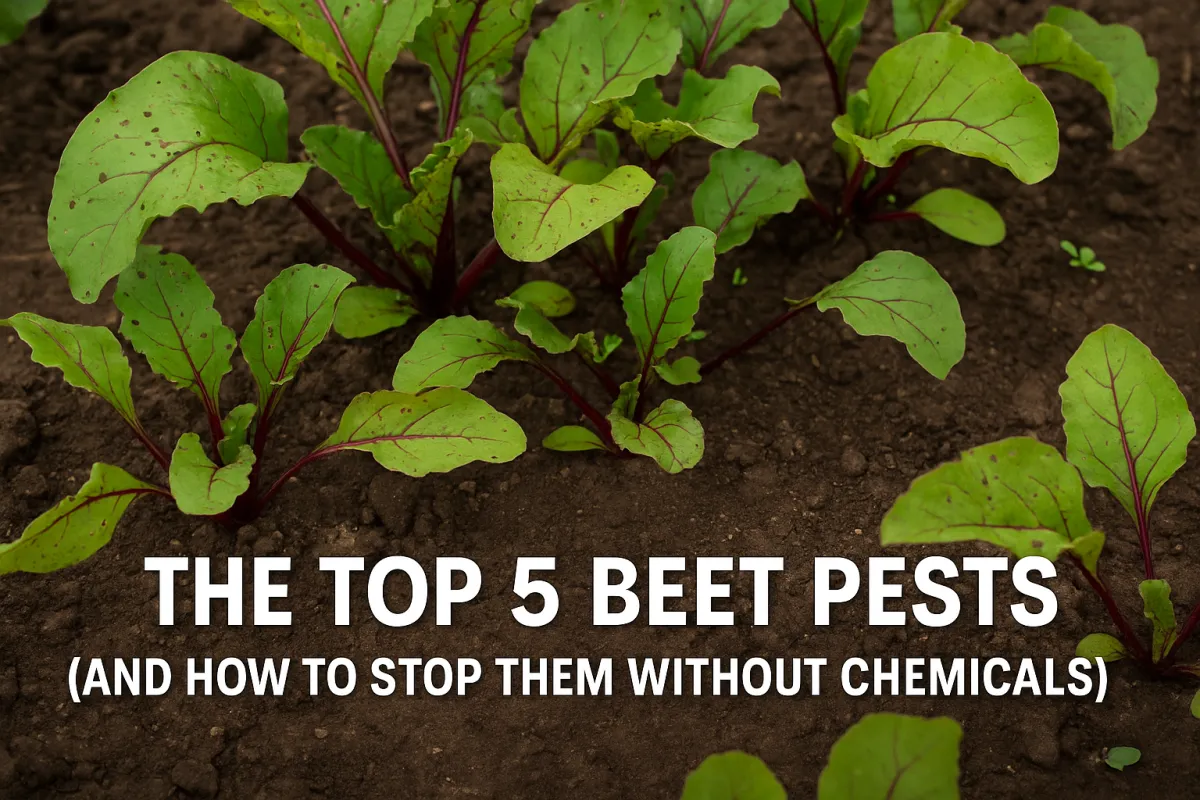
The Top 5 Beet Pests (and How to Stop Them Without Chemicals)
The Top 5 Beet Pests (and How to Stop Them Without Chemicals)
I remember the first time I planted beets like it was yesterday. I’d carved out a tidy little corner of the garden, worked compost deep into the soil, and sowed a neat row of those wrinkly little seeds. A few weeks later, I was thrilled to see a lush patch of greens pushing up—and then the trouble started.
One morning, I walked out to find holes riddling the leaves. Another day, a whole row of seedlings looked like they’d been clipped by tiny scissors. And the worst part? I hadn’t sprayed a thing—on purpose. I was committed to doing it organically. Maybe you are too.
If your beet leaves are tunneled, shredded, or your seedlings are disappearing overnight, you’re not alone. The good news is, these pests can be beaten. You don’t need chemicals. You just need to know what to look for, when to act, and how to outsmart them.
🧰 Grab the Printable: Beet Pest ID & Organic Fixes Chart
Need something to stick in your garden shed or tuck in your notebook?
Download the free one-page Beet Pest ID & Organic Fixes Chart.
(We’ll link it here when the post goes live.)
Quick Look: What Shows Up and When
PestShows Up Most InTargets Beets AtFlea BeetlesZones 6–8 early springSeedling leavesLeaf MinersZones 5–10 mid-spring+Mature greensCutwormsAll zonesSeedling stageAphidsZones 6–10 (cool/warm swings)Mid-to-late growthAll of the aboveZones 7–9Entire season
1. Flea Beetles – Tiny Holes, Big Trouble
Flea beetles are fast-moving little jumpers that love baby beet leaves. These guys are notorious in dry, warming spring weather and will chew tiny "shotgun-style" holes all over your seedlings.
How to stop them naturally:
Row covers. Put them on as soon as you sow the seed. Don’t wait.
Diatomaceous earth. Dust your leaves lightly when they’re dry.
Trap crops. Plant a small patch of mustard nearby. Flea beetles will flock to it—then you pull and toss the plant when it’s infested.
Grandma’s tip: “If they’re hopping, they’re stopping your beets.”
2. Leaf Miners – The Hidden Tunneling Menace
Leaf miners are sneaky. You won’t see them at first—only the winding tunnels they leave inside your beet leaves. These are the larvae of tiny flies that lay eggs on your greens.
What to do about it:
Remove affected leaves. Get them off the plant early and toss them in the trash.
Use row covers. Especially effective early in the season to stop egg-laying.
Bring in beneficials. Grow dill, alyssum, and yarrow nearby to attract parasitic wasps.
Grandma’s tip: “You gotta pinch the problem before it spreads.”
3. Cutworms – The Seedling Snipers
Cutworms are nighttime predators that hide in the soil and chew seedlings clean off at ground level. If you wake up to a row of toppled baby beets, this is probably the culprit.
How to stop them:
Collar your seedlings. Wrap cardboard or toilet paper tubes around each base when planting.
Clear the beds. Don’t leave plant debris in your beet patch—that’s where they hide.
Crushed eggshells or cornmeal. Scatter around the base of plants to deter them.
Personal tip: I lost two dozen beet seedlings to these guys in one night. I don’t plant without collars anymore.
4. Aphids – The Silent Sappers
You might not see aphids right away—but you’ll notice the signs: curling leaves, yellowing, or sticky residue on the foliage. Flip a leaf over, and you’ll likely find clusters of these soft-bodied pests.
How to control them without chemicals:
Water blast. A strong spray of water in the early morning will knock them right off.
Neem oil or insecticidal soap. Use if populations are high—safe for organic gardening.
Plant flowers. Interplant dill, cilantro, or alyssum to bring in ladybugs and lacewings.
Grandma’s tip: “If your leaves are sticky, look underneath.”
5. Prevention That Actually Works
Sometimes the best offense is a good defense. If you do these things consistently, most beet pests won’t get a foothold to begin with.
🛡️ Floating Row Covers
Lightweight and breathable
Keeps out most pests before they ever land
Best used right at sowing and removed after plants are well established
🌿 Interplanting
Beets + Onions or Garlic: Helps repel aphids and flea beetles
Beets + Dill: Attracts predatory insects
Beets + Bush Beans: Shades the soil and confuses pest scent trails
Grandma’s wisdom: “Plant what you want, but plant what they hate too.”
🔁 Crop Rotation
Don’t follow beets with other greens in the same family (chard, spinach)
Move beets to a fresh bed each year to break pest cycles
🌱 Soil Health
Strong plants resist pests. Compost deeply.
Avoid over-fertilizing with nitrogen—that can actually make pest pressure worse
✅ Today’s Task
Walk your beet rows.
Check for curling leaves, squiggly tunnels, or chewed-off seedlings.
Snap a photo and compare it to the Printable Pest ID Chart.
Take one action (dust DE, pull a tunneled leaf, start interplanting).
Closing Thought: Beets Are Worth It
They’re one of the most rewarding crops in the garden—but they do attract trouble. The good news is, you don’t have to choose between healthy food and chemical control. You can grow clean, healthy beets with a little attention and a few smart steps.
We were made to tend the garden. Don’t be surprised when the pests show up—just be ready.
If this was helpful, grab the printable pest guide, and pass this along to a neighbor who’s had beet trouble. Let’s grow a stronger food system together, one root at a time.


Facebook
Instagram
X
Youtube